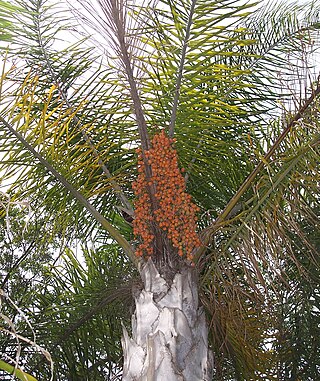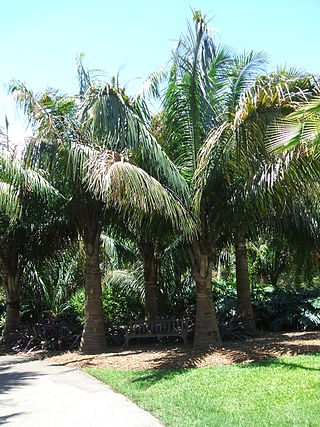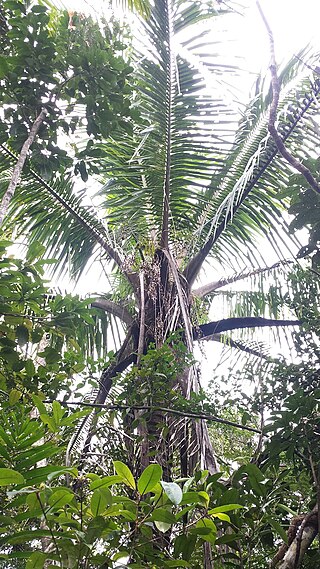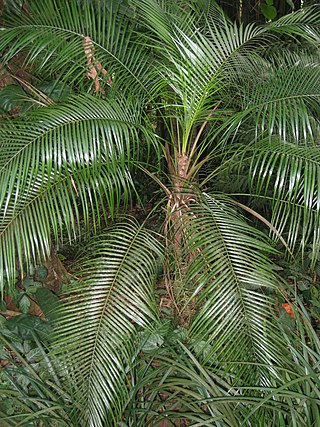
Phoenix is a genus of 14 species of palms, native to an area starting from the Canary Islands in the west, across northern and central Africa, to the extreme southeast of Europe (Crete), and continuing throughout southern Asia, from Anatolia east to southern China and Malaysia. The diverse habitats they occupy include swamps, deserts, and mangrove sea coasts. Most Phoenix species originate in semi-arid regions, but usually occur near high groundwater levels, rivers, or springs. The genus is unusual among members of subfamily Coryphoideae in having pinnate, rather than palmate leaves; tribe Caryoteae also have pinnate or bipinnate leaves.

Syagrus is a genus of Arecaceae (palms), native to South America, with one species endemic to the Lesser Antilles. The genus is closely related to the Cocos, or coconut genus, and many Syagrus species produce edible seeds similar to the coconut.

Butia is a genus of palms in the family Arecaceae, native to the South American countries of Brazil, Paraguay, Uruguay and Argentina. Many species produce edible fruits, which are sometimes used to make alcoholic beverages and other foods. The name is derived from a Brazilian vernacular word for members of the genus.

Schizolobium parahyba, the Brazilian firetree, or Brazilian fern tree, is a species of tree from tropical America. It is the sole species in genus Schizolobium. It is notable for its fast growth. According to Francis Hallé, this tree may even reach 30 meters high in only five years, which would make it one of the fastest growing trees ever.

Syagrus romanzoffiana, the queen palm, cocos palm or Jerivá, is a palm native to South America, introduced throughout the world as a popular ornamental garden tree. S. romanzoffiana is a medium-sized palm, quickly reaching maturity at a height of up to 15 m (49 ft) tall, with pinnate leaves having as many as 494 pinnae (leaflets), although more typically around 300, each pinna being around 50 centimetres (18 in) in length and 3–5 centimetres (1–2 in) in width.

Attalea crassispatha is a palm which is endemic to southwest Haiti. The most geographically isolated member of the genus, it is considered a critically endangered species and has been called one of the rarest palms in the Americas.

Attalea is a large genus of palms native to Mexico, the Caribbean, Central and South America. This pinnately-leaved, non-spiny genus includes both small palms lacking an aboveground stem and large trees. The genus has a complicated taxonomic history, and has often been split into four or five genera based on differences in the male flowers. Since the genera can only be distinguished on the basis of their male flowers, the existence of intermediate flower types and the existence of hybrids between different genera has been used as an argument for keeping them all in the same genus. This has been supported by recent molecular phylogenies.

Abies numidica, the Algerian fir, is a species of fir found only in Algeria, where it is endemic on Djebel Babor, the second-highest mountain in the Algerian Tell Atlas.
Syagrus macrocarpa is a rare species of palm found only as scattered isolated individuals and small groups in the east of the Brazilian states of Espírito Santo, Minas Gerais and Rio de Janeiro. It grows to 4-10m tall, with 8-20 leaves to 2m long. The leaves are bent at the end, with very hairy margins near the trunk, and consist of 180-320 slightly coiled leaflets irregularly arranged in several planes on the rake. The fruit are oval, greenish-yellow, 6–9 cm long. It is grown in cultivation. Seeds are difficult to germinate, with low rates of germination. Common names for it in Minas Gerais are baba-de-boi-grande and maria-rosa.

Syagrus pseudococos is a species of flowering plant in the family Arecaceae. It is found in tropical rainforest and on rocky outcrops in eastern Brazil along a coastal strip from extreme south of state of Bahia south through Espírito Santo, Rio de Janeiro to São Paulo.

Voanioala gerardii, commonly known as the forest coconut, is a species of flowering plant in the family Arecaceae. It is a relative of the coconut, and is generally regarded as monotypic within the genus Voanioala. However, a team of geneticists headed by Bee F. Gunn found sufficient genetic variation within Voanioala to constitute at least two and possibly four cryptospecies. Voanioala is endemic to Madagascar, and is threatened by habitat loss. Voanioala is harvested for its edible seeds and palm heart. It is estimated that there are fewer than 15 mature trees remaining.

Hydrangea hirta, also known as the nettle-leaved hydrangea, is a species of flowering plant in the family Hydrangeaceae that is native to East Asia. Due to the beauty and sturdiness of the species' flowers it can be found outside of its range being used for horticultural and landscaping purposes, and is found in gardens in countries including the United Kingdom and the United States.

Syagrus weddelliana, also known as the miniature coconut palm or Weddell's palm, is a feather palm in the palm family.

Syagrus cearensis is a natural palm endemic to Brazil.

Butia campicola is a very small species of Butia palm with an underground trunk; native to the cerrados of central Paraguay and south-central Brazil.

Butia odorata, also known as the South American jelly palm, jelly palm, or pindo palm, is a Butia palm native to southernmost Brazil and Uruguay. This slow-growing palm grows up to 10m, although it is often less tall. It is identifiable by its feather palm pinnate leaves that arch inwards towards a thick stout trunk.

Butia archeri is a small species of Butia palm with a short trunk native to the states of Goiás, Brasília, Minas Gerais and São Paulo in Brazil.
Butia matogrossensis is a smallish species of Butia palm with a trunk of only 0.5 m (20 in) in height or often subterranean, native to the cerrados of the centre, central-east, northeast and likely north of the state of Mato Grosso do Sul, after which it is named, in south-central Brazil. It also occurs in neighbouring south-central Goiás to the north. It is endemic to Brazil, occurring only in this country.
Butia pubispatha is a very small and extremely rare species of Butia palm with an underground trunk; endemic to the east of the state of Paraná in southeastern Brazil.
Butia catarinensis is a mid-sized species of Butia palm native to the states of Rio Grande do Sul, Santa Catarina in Brazil.
Dave’s Garden. (2019). Syagrus Species, Palm. Retrieved from https://davesgarden.com/guides/pf/go/219773/
Noblick, L., & Lorenzi, H. (2010). New Syagrus species from Brazil . Palms, 54. Retrieved from https://www.researchgate.net/profile/Larry_Noblick/publication/235675933_New_Syagrus_species_from_Brazil/links/09e41512776560c7ff000000/New-Syagrus-species-from-Brazil.pdf
Quattrocchi, U. (2017). Crc world dictionary of palms: common names, scientific names, eponyms, synonyms, and etymologynVolume I. Boca Raton; London; New York: CRC Press, Taylor et Francis Group.
Syagrus rupicola. (2019). Retrieved December 2, 2019, from https://www.rarepalmseeds.com/syagrus-rupicola.















